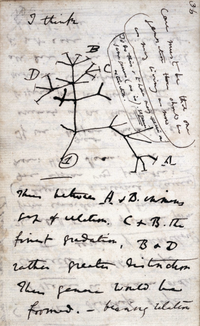
Photo from wikipedia
Lysozymes are an ancient group of antimicrobial enzymes of the innate immune system. Here we provide a comparative analysis of the evolution and function of lysozymes during early development in… Click to show full abstract
Lysozymes are an ancient group of antimicrobial enzymes of the innate immune system. Here we provide a comparative analysis of the evolution and function of lysozymes during early development in fish, the most speciose vertebrate group. In fishes, lineage and species-specific evolution of both C-type (chicken or conventional) and G-type (goose type) genes occurred. Phylogenetic analysis revealed that the teleost lysozyme G-type members group with the tetrapod homologues but the teleost C-type form three different clusters with the tetrapods. Most of the teleost C-type cluster with tetrapod Lyz but there are some that group with the mammalian Lyzl1/2 and LALBA. This suggests that early in gnathostome evolution these genes already existed and that lyzl1/2 and lalba genes are present in fish and tetrapods. Gene synteny analysis to confirm sequence orthologies failed to identify conserved genome regions between teleosts and other vertebrates lysozyme gene regions suggesting that in the ancestral bony fish genome lyz, lyzl1/2, lalba and lyg precursor genes were transposed to different chromosome regions. The homologue of the mammalian lactalbumin (LALBA) gene was identified for the first time in teleosts and was expressed in skin and during egg and larval development. Lysozyme activity was detected in teleost eggs and varied between species and in the gilthead sea bream lyg and lalba transcript abundance differed in eggs and larvae from different brood stock suggesting differences exist in maternal innate immune protection.
Journal Title: Developmental and comparative immunology
Year Published: 2020
Link to full text (if available)
Share on Social Media: Sign Up to like & get
recommendations!